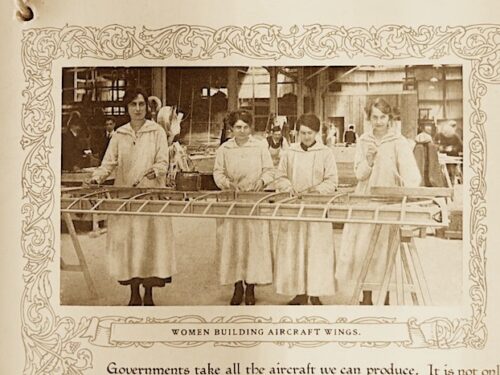by Simon Fowler
In 1914 Richmond had little industry, but inevitably this changed during the First World War. As well as Sopwiths giant aircraft works in Ham there were also several smaller companies, largely making aircraft and parts for Sopwith. One of these was the Whitehead Aircraft Company.
John Alexander Whitehead was a carpenter by trade. As a teenager he emigrated to Chicago but returned home in 1915. As aircraft at the time were largely built around wooden frames this seemed a natural business to enter. He soon contracted to make six BE2b two-seaters by the War Office. With a ceremony in November 1915 the first aircraft, No. 2884, was christened by breaking a bottle of champagne over its nose and being formally name “the Helene”after his first daughter. The brass nameplate is still with the family.
Whitehead initially leased the Drill Hall off Sheen Road in Richmond and found land in Hanworth to use as an airfield to assemble and test his planes. The premises quickly expanded by buying land (and existing houses) in nearby Grena Road. By 1918, the company had not only filled every space in the streets between Grena and Manor roads with factory buildings but also had purchased a row of ten terraced houses for offices.
Hundreds of men and women made the aircraft. A brochure, published in 1917, described the women workers: “In one section they sit in rows at the drilling machines or lathes, wearing blue overalls and caps; in another begoggled like motorists with leather aprons, welding metal parts together.”

A fine canteen was built and equipped with crested cutlery. When meat was in short supply, Whitehead immediately went out and bought up a local butcher’s shop. But the height of the year was an annual sports day organised at Hanworth. It first took place on Whitehead’s birthday – 8 August 1916 – where a spectacular display by the company’s test pilot Captain Hubert Sykes thrilled the crowd.
In total, Whitehead produced 1,427 aircraft between 1915 and 1919 – a large number on such a cramped site.
Financing was never easy. In the brochure he sought to find a “farseeing” investor “who is at this stage is ready to lend financial assistance to the manufacturer to develop the industry [and who] must of necessity reap a full measure of reward”. Unfortunately, no such person emerged.
With the sudden end of the War in November 1918, and the drying up of further orders from the government the Whitehead Aircraft Company soon went bankrupt. After several other business failures – including a short-lived nightclub in Twickenham – Whitehead eventually found success as the owner ofEurope’s largest orchards.
Nothing remains of the Richmond works. However, half a dozen short newsreels made by British Pathé – now on YouTube – still give a feel for how it must have been like to work there.
This article was originally published in Twickenham and Richmond Tribune, 19 February 2021.